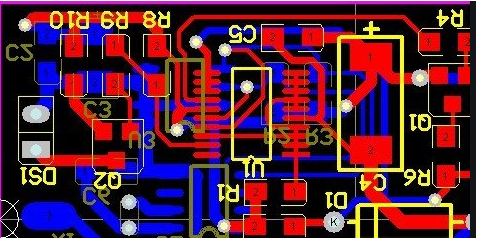The high-frequency switching noise generated by PCB components during switching will propagate along the power line. The main function of the decoupling capacitor is to provide a local DC power supply to the active device to reduce the propagation of switching noise on the board and to guide the noise to the ground. In fact, bypass capacitors and decoupling capacitors should be placed as close as possible to the power supply input to help filter out high-frequency noise. The value of the decoupling capacitor is approximately 1/100~1/1000 of the bypass capacitor. In order to get better EMC characteristics, the decoupling capacitor should be as close as possible to each integrated block (IC), because the wiring impedance will reduce the effectiveness of the decoupling capacitor. Ceramic capacitors are often used for decoupling, and their value is determined by the rise time and fall time of the fastest signal. For example, for a 33MHz clock signal, a 4.7-100nF capacitor can be used; for a 100MHz clock signal, a 10nF capacitor can be used. When choosing a decoupling capacitor, in addition to considering the capacitance value, the ESR value will also affect the decoupling capability. For decoupling, a capacitor with an ESR value lower than 1Ω should be selected.

From the circuit point of view, it can be divided into the source signal to be driven and the load to be driven. If the load capacitance is relatively large, the drive circuit must charge and discharge the capacitance to complete the signal jump. When the rising edge is relatively steep, the current is relatively large, so that the drive current will absorb a large power supply current. The inductance and resistance (especially the inductance on the chip pins will bounce), this current is actually a kind of noise relative to normal conditions, which will affect the normal operation of the previous stage, which is coupling. The decoupling capacitor acts as a battery to meet the change of the drive circuit current and avoid mutual coupling interference. Combining bypass capacitors and decoupling capacitors will make it easier to understand. The bypass capacitor is actually decoupled, but the bypass capacitor generally refers to high-frequency bypass, that is, to provide a low-impedance leakage prevention path for high-frequency switching noise. High-frequency bypass capacitors are generally small, generally 0.1μF, 0.01μF, etc. according to the resonant frequency, while decoupling capacitors are generally larger, 10μF or greater, depending on the distribution parameters in the circuit and the size of the drive current change. Bypass is to take the interference in the input signal as the filtering object, and decoupling is to take the interference of the output signal as the filtering object to prevent the interference signal from returning to the power supply. This is their essential difference.
The PCB decoupling capacitor has two functions between the power supply of the integrated circuit and the ground: one is the energy storage capacitor of the integrated circuit, and the other is to bypass the high-frequency noise of the device. The typical decoupling capacitor value in digital circuits is 0.1μF. The typical value of the distributed inductance of this capacitor is 5μH. The 0.1μF decoupling capacitor has a distributed inductance of 5μH, and its parallel resonance frequency is about 7MHz. That is to say, it has a better decoupling effect for noise below 10MHz, and it has little effect on noise above 40MHz. Capacitors of 1μF and 10μF, and the parallel resonance frequency is above 20MHz, the effect of removing high-frequency noise is better. Every 10 pieces of integrated circuits need to add a charge and discharge capacitor, or an energy storage capacitor, about 10μF can be selected. It is best not to use electrolytic capacitors. Electrolytic capacitors are rolled up with two layers of film. This rolled up structure behaves as an inductance at high frequencies. Use tantalum capacitors or polycarbonate capacitors. The selection of decoupling capacitors is not critical. You can press C=1/F, that is, 0.1μF for 10MHz and 0.01μF for 100MHz.
The VCC network has only one point connected to the VCC plane, so the noise inside and outside the IC must go to the power plane through this PCB via. The additional impedance of the PCB via prevents the noise from spreading to the rest of the system.